 0551-68500918
0551-68500918 





 Hey there! Have you noticed that the Herbicides Market is really taking off lately? It’s fascinating to see how it’s all being fueled by the changing demands of farmers and the growing focus on sustainability. With agricultural folks around the globe looking for smart ways to tackle weeds and boost their crop yields, there’s a real push for innovative products and formulations. That’s where we come in at Innovation Meiland (Hefei) Co., LTD. We’re proud to be leading the charge in researching and developing some pretty cutting-edge pesticide solutions that align with global standards. Based in Hefei, China, our dedication to quality and new ideas has really put us on the map internationally. In this blog, let’s dive into five key reasons why the Herbicides Market is booming right now, and how tech advancements and sustainable agriculture trends are playing a big role in shaping its future. Stick around, it’s going to be interesting!
Hey there! Have you noticed that the Herbicides Market is really taking off lately? It’s fascinating to see how it’s all being fueled by the changing demands of farmers and the growing focus on sustainability. With agricultural folks around the globe looking for smart ways to tackle weeds and boost their crop yields, there’s a real push for innovative products and formulations. That’s where we come in at Innovation Meiland (Hefei) Co., LTD. We’re proud to be leading the charge in researching and developing some pretty cutting-edge pesticide solutions that align with global standards. Based in Hefei, China, our dedication to quality and new ideas has really put us on the map internationally. In this blog, let’s dive into five key reasons why the Herbicides Market is booming right now, and how tech advancements and sustainable agriculture trends are playing a big role in shaping its future. Stick around, it’s going to be interesting!
Hey, have you noticed how the demand for herbicides has really taken off lately? It's pretty interesting, and it’s all thanks to some new trends in farming and how we manage the environment. A report from Grand View Research suggests that the global herbicide market could hit around $34.22 billion by 2025, growing at a rate of about 6.6% a year. That’s a lot! This growth is mainly because more farmers are jumping on the precision farming bandwagon and using integrated pest management strategies that really focus on being efficient and sustainable.
Plus, even though organic farming usually means less use of synthetic herbicides, it's actually kicking off some cool new ideas around natural herbicide solutions. A study from MarketsandMarkets highlights that the market for bio-based herbicides could jump from $0.7 billion in 2020 to a whopping $2.5 billion by 2025, which is a sweet CAGR of 28.5%. This shift is not only about the growing appetites for organic goods but also pushes growers to look for greener ways to boost crop yields while being kinder to our planet.
And let’s not forget about how new regulations and the push for eco-friendly farming practices are getting manufacturers to dive into research and come up with new formulations. The European Crop Protection Association (ECPA) predicts that nearly 300 new active substances could roll out in the herbicide market by 2030! That’s a big response to changing laws and the market's craving for safer agrochemicals. Overall, it looks like there’s a pretty bright future ahead for the herbicide market as it evolves to tackle modern farming challenges and meet what consumers want.
You know, the herbicide market is really changing in some pretty exciting ways! A lot of this is thanks to new formulations that make crop protection way more effective. These advanced products are designed to target specific weeds directly, so they don’t hurt the surrounding crops or beneficial bugs. Take the selective herbicides, for instance—they help farmers tackle pesky weeds without harming their good crops. This means healthier fields and better yields overall, which is pretty awesome.
And that’s not all! We’re also seeing some cool tech come into play, like microencapsulation and controlled-release formulations, which are totally shaking up how herbicides are used. With these innovations, the active ingredients are released gradually, which means longer-lasting weed control and fewer applications needed. This is a win-win for farmers since it cuts down on costs, and it’s great for the environment, too, since there’s less chemical runoff. As these cutting-edge products keep evolving, they’re really raising the bar for how we protect our crops and boosting the herbicide market in the process.
You know, the herbicide market is really taking off these days! A big part of that growth is due to new regulations that are shaking things up in how products are made and distributed. Lately, a bunch of countries have started to crack down with stricter rules, all in the name of keeping our environment safe and doing a better job of protecting biodiversity. Because of this shift, manufacturers are stepping up their game and coming up with safer and more effective herbicides that tick all the boxes of these new guidelines. And guess what? This has led to a boom in demand for these innovative products, which is opening up some exciting new possibilities in the market.
So, what can folks do to navigate this evolving landscape? First off, it's super important to keep an eye on local regulations and what's trending in sustainable agriculture. Farmers and agronomists should definitely think about diving into training programs that highlight integrated pest management and the benefits of using eco-friendly herbicides. Getting in touch and working with regulatory bodies can also give some valuable insights into what might be coming down the pipeline, which helps everyone stay ready for any changes.
And let's not forget about what consumers want! Paying attention to consumer preferences can really help steer product development. With more people leaning towards organic and sustainably sourced products, herbicide makers are getting the message: it's time to focus on crafting solutions that reflect these values. By staying on top of these regulatory shifts, everyone involved can score a solid competitive edge in this booming herbicides market.
You know, the herbicide market is really taking off, and it’s mostly because everyone is putting a bigger focus on sustainable farming. Farmers and ag businesses are waking up to how traditional farming methods can mess with the environment. Because of this shift in thinking, there’s been a big uptick in interest for herbicides that not only tackle weeds effectively but also fit into more eco-friendly practices. Folks are loving products that come from natural sources or those using some pretty cool new formulations, especially when they want to keep their environmental impact in check.

On top of that, with all the regulations coming down and consumers clamoring for organic and sustainably produced food, herbicide manufacturers are stepping up. They’re really getting into R&D to whip up herbicides that align with integrated pest management principles. These new products focus on being eco-friendly while making sure weed control is still top-notch. It’s an exciting trend that not only caters to today’s demand for sustainable practices but also helps farmers keep up productivity without messing up the environment. So yeah, the herbicide industry is evolving, fitting right in with the global push for sustainability in agriculture.
You know, the herbicide market is really booming right now, and a big part of that is all the cool tech advancements making herbicides way more efficient. One of the exciting new developments is precision application technology. This fancy stuff uses data analytics and GPS systems to make sure herbicides are sprayed just where they’re needed, which helps cut down on waste and is better for the environment. Because of this precision, farmers can really nail their weed control while using fewer chemicals, which is a win for sustainability in agriculture.
And then there are genetically modified crops that can handle specific herbicides. This totally changes the game for weed management! With these crops, farmers can go ahead and apply herbicides with way more confidence, knowing their crops won't get harmed. This not only leads to higher yields but also means less crop loss overall. It’s like a perfect partnership between new crop tech and herbicide innovation. It really streamlines things, reduces labor costs, and makes managing weeds so much easier. Looking ahead, it’s clear that the herbicide market is going to keep growing, all thanks to these amazing advancements that connect boosting agricultural productivity with being more sustainable.
| Reason | Description | Impact Level | Future Potential |
|---|---|---|---|
| Advanced Formulations | New formulations increase efficiency and target specific weeds. | High | Moderate |
| Biotechnology Integration | Use of genetically modified crops to enhance Herbicide Application efficacy. | Very High | High |
| Data Analytics | Analytics provide insights for optimized herbicide usage and application timing. | Medium | High |
| Sustainability Focus | A shift towards eco-friendly herbicides reduces environmental impact. | Medium | Very High |
| Regulatory Support | Government incentives and regulations facilitate the development of innovative products. | High | Moderate |
You know, the world of agriculture is changing fast. With more and more people to feed, the demand for herbicides is really feeling the pressure. As our population keeps climbing, farmers are looking for smarter ways to produce crops. This push for efficiency is really driving the need for better weed management. Plus, with all the new precision agriculture tech out there, we’re able to farm more sustainably and use our resources way more wisely.
And let’s not forget about genetically modified crops, which are adding another layer to this whole situation. They've made it even more crucial to have strong herbicide options to deal with those pesky resistant weeds. Farmers are on the lookout for products that can really get the job done while also being kind to the environment. So, herbicide companies really need to step up and create solutions that are effective but also think about their impact on nature.
**So here’s a tip: If you’re trying to navigate the herbicide market, think about investing in precision agriculture tools. They can really boost your productivity and make your farming practices more sustainable. And hey, keeping an eye on the latest herbicide innovations can help you stay ahead of the game when it comes to changing farming needs and regulations. Engaging with research-driven companies like Meiland can offer you some cool insights into the newest pest management solutions that are perfect for today’s agriculture.**

: The herbicide market is experiencing significant growth due to regulatory changes aimed at ensuring environmental safety, technological advancements enhancing herbicide efficiency, and increasing agricultural needs fueled by a growing global population.
Stricter regulations in many countries have led manufacturers to innovate and create safer, more effective herbicides that comply with new guidelines, resulting in a surge in demand for these advanced products.
Precision agriculture technologies, which utilize data analytics and GPS-guided systems, improve the accuracy of herbicide application by targeting specific areas. This minimizes waste, reduces environmental impact, and enhances weed control.
The emergence of genetically modified crops resistant to specific herbicides allows farmers to apply herbicides more confidently, leading to higher yields, reduced crop loss, and lower labor costs in weed management.
Farmers should stay updated on local regulations and trends, invest in training programs focused on integrated pest management, and collaborate with regulatory bodies to gain insights into future policies.
As consumers increasingly prioritize organic and sustainably sourced products, herbicide manufacturers are encouraged to develop solutions that align with these values, influencing product innovation and market trends.
Stakeholders can navigate the herbicide market effectively by investing in precision agriculture technologies, staying informed about new herbicide developments, and engaging with research-focused companies for innovative pest management solutions.
Sustainable agriculture aims to minimize ecological impacts while maximizing crop production. Herbicide formulations that align with these goals can enhance environmental safety and meet consumer demand for sustainable practices.
Integrated pest management (IPM) is a strategy that combines biological, cultural, and chemical practices to manage pests effectively while minimizing impacts on the environment. It is emphasized to promote sustainable agricultural practices.
The herbicide market is set to thrive with continued research in precision application technologies, advancements in genetically modified crops, and the ongoing adaptation to regulatory shifts towards sustainable agriculture.







